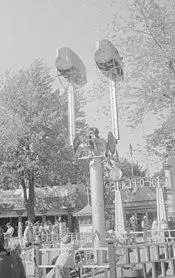
The Loop-O-Plane is an amusement park ride that originated in America. It was invented by Lee Eyerly and manufactured by the Eyerly Aircraft Company of Salem, Oregon, in 1933.[1] The ride was immediately popular with customers[2] and became a staple of amusement parks.
The ride was imported into Europe, where it was first used in the UK in 1937.[3]
The ride has two 16-foot-long arms, each with an enclosed car at one end and a counterweight at the other. Each car holds four riders seated in pairs facing opposite directions making the maximum occupancy eight riders. Propelled by an electric motor, the arms swing in directions opposite to each other until they 'loop' taking the riders upside down. The minimum rider height requirement is 46 inches tall.
An updated version of this ride exists known as the Roll-O-Plane. Some of the surviving machines were also converted into a variation named Rock-O-Plane.
Ride locations
- Green Machine (Eylerly Loop-O-Plane) - Hydro Free Fair- Hydro, Oklahoma
References
- ^ "Eyerly Invents "Loop-O-Plane"". Western Flying Magazine. Occidental Publishing Company. 13: 24. 1933.
- ^ "Eyerly Loop-o-plane Wins Favor". Western Flying Magazine. Occidental Publishing Company. 14: 24. January 1934.
- ^ Sheffield University: National Fairground Archive - Looping Rides Archived 2014-01-08 at the Wayback Machine. Accessed 8 January 2014